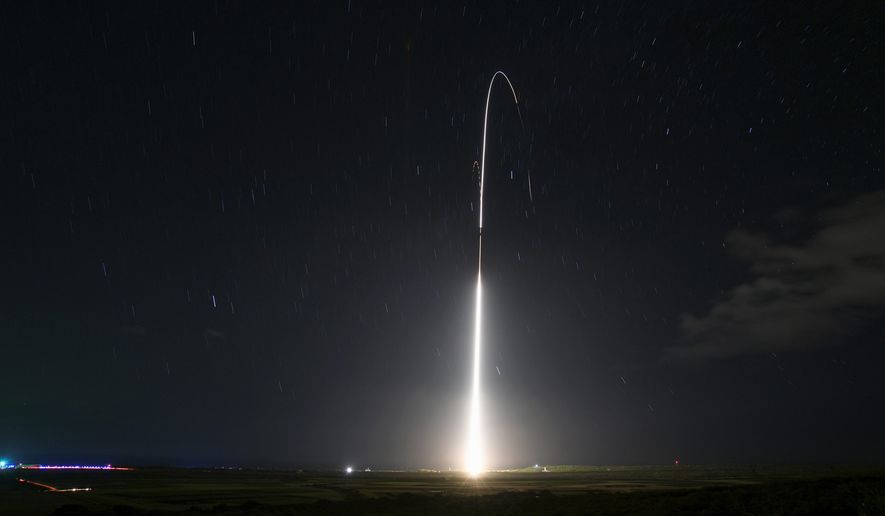The U.S. military must invest heavily in high-tech radar, space-based weapons detection systems, long-range artillery and a host of other 21st-century capabilities to keep at bay an increasingly aggressive China, the Pentagon told congressional leaders this week in a sweeping new funding proposal.
In its six-year, $27 billion blueprint, a copy of which was obtained by The Washington Times, the U.S. Indo-Pacific Command (INDOPACOM) painted a bleak picture of a Pacific theater that is becoming more “unfavorable” to U.S. interests. Under the Obama and Trump administrations and now the Biden administration, U.S. strategists have tried to redirect the military’s focus away from the Middle East and toward the Pacific, with an eye toward ensuring America is prepared for any potential conflict with a rising China.
But the U.S. has a great deal of work to do, military officials said, and current battlefield conditions could spell trouble.
“The greatest danger to the future of the United States continues to be an erosion of conventional deterrence. Without a valid and convincing conventional deterrent, China is emboldened to take action in the region and globally to supplant U.S. interests,” INDOPACOM said in its proposed investment plan for 2022 through 2027. “As the Indo-Pacific’s military balance becomes more unfavorable, the U.S. accumulates additional risk that may embolden adversaries to unilaterally attempt to change the status quo.”
INDOPACOM Commander Adm. Phil Davidson is expected to formally roll out the spending proposal during an event Thursday at the American Enterprise Institute think tank in Washington.
The document was delivered to Congress on Monday — the same day that the Pentagon’s China Task Force met officially for the first time. The new task force, comprising civilian and military experts from across the Defense Department and U.S. intelligence community, will craft a “baseline assessment” of all military policies related to China, officials said.
While Mr. Biden has said that he welcomes competition with Beijing, the China Task Force mandate and continued warnings from military leaders underscore the gravity of the threat the U.S. faces in the Pacific. In addition to persistent fears that Beijing could launch an invasion of Taiwan, China also is expanding its military footprint deeper into the South China Sea, testing U.S. resolve as it beefs up its own weapons systems, bases, ports and other assets in the theater.
To counter those moves, U.S. officials point to several key capabilities that the Pentagon must enhance over the next several years. For example, the INDOPACOM spending plan calls for about $1.6 billion for a “fixed and persistent 360-degree air missile defense” system based in Guam.
Guam has taken on strategic significance in the East Asian power game. Its strategic location makes an appealing target for Beijing; the Chinese military, for example, already has invested heavily in a ballistic missile it unofficially refers to as the “Guam killer.”
The U.S. plan also calls for $2.3 billion to fund “a constellation of space-based radars” to track hostile forces, along with another $3.3 billion for ground-based long-range tactical and strategic missiles that could prove vital in any theoretical clash with China.
The blueprint also calls for billions of dollars in spending to construct and upgrade U.S. facilities in the region and to better fund training exercises and military cooperation with key allies.
“When integrated globally across numerous combatant commands, this coalition effort ultimately convinces our adversaries they cannot achieve their objectives with force,” INDOPACOM said in its report.
Meanwhile, the Defense Department also is keeping open the possibility of deploying land-based intermediate-range missiles to the region. Such deployments are now possible after the U.S. in 2019 withdrew from the Intermediate-Range Nuclear Forces (INF) treaty, a Cold War-era pact meant to limit U.S. and Russian arsenals in Europe.
Asked this week whether the U.S. was examining the possibility of intermediate-range missiles in the Pacific, Pentagon officials left the door wide open.
“That’s the kind of thing that we’ll be looking at in our global posture review. And I think that all factors into what resources you’re applying against what strategy in what part of the world,” Defense Department spokesman John Kirby told reporters Monday, adding, “Clearly, our defensive posture, which includes not just people, but resources and systems, will all be part of this global posture review.”
• Ben Wolfgang can be reached at bwolfgang@washingtontimes.com.

Please read our comment policy before commenting.